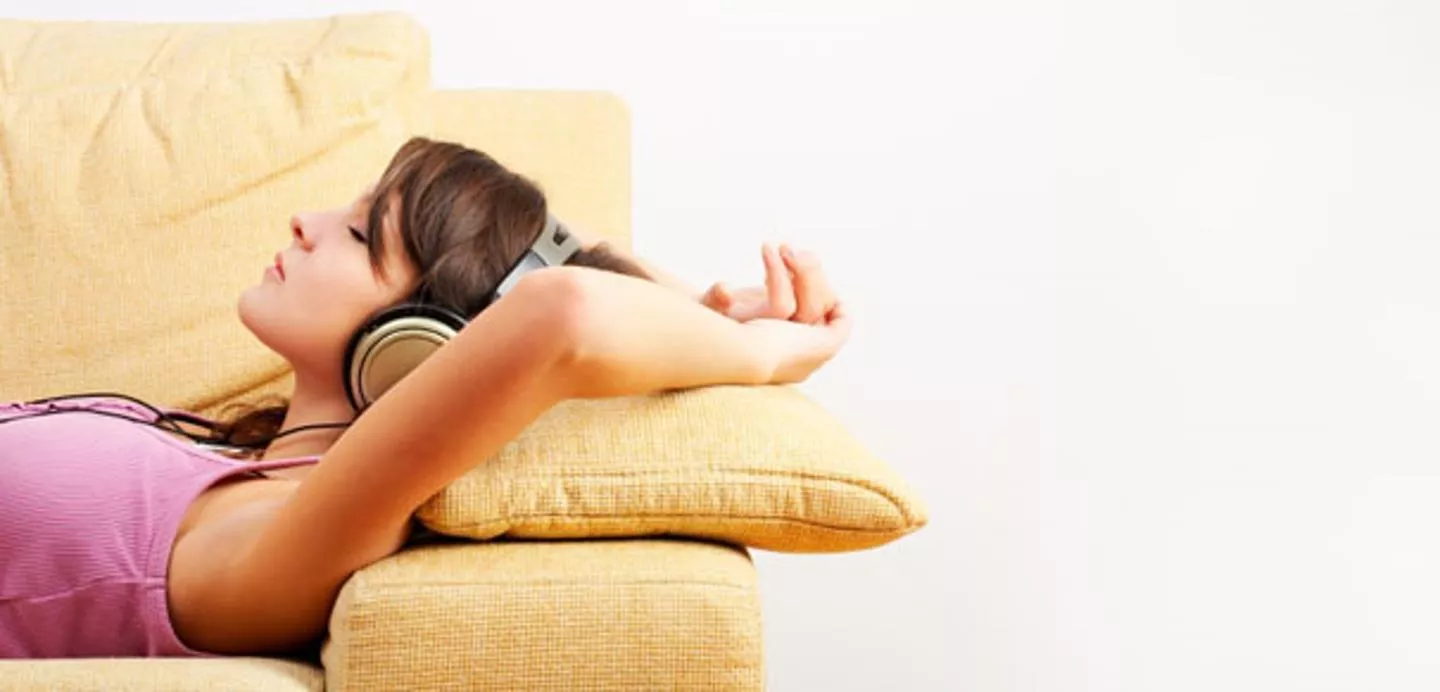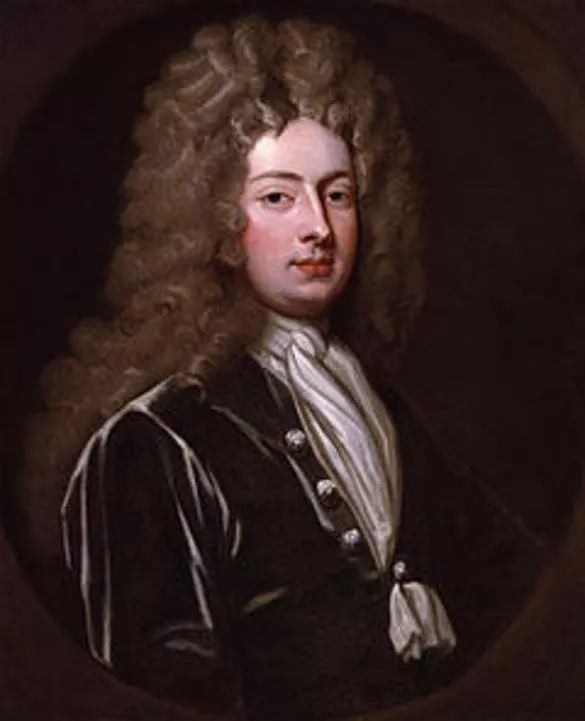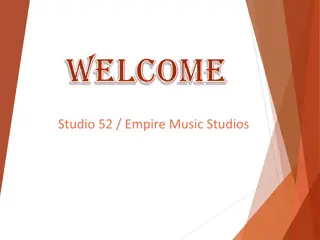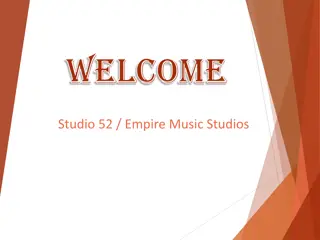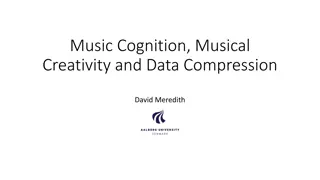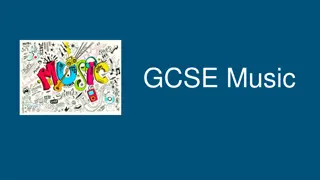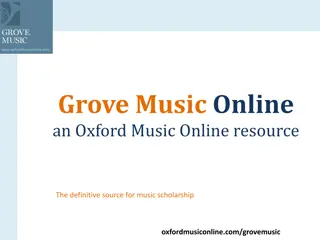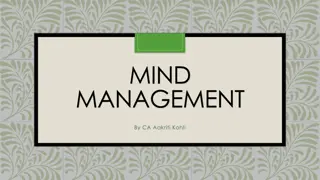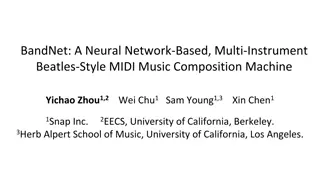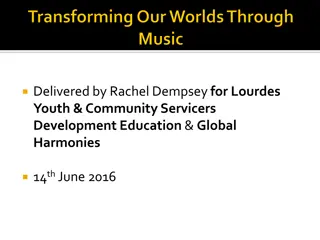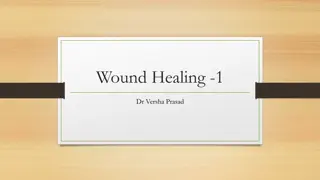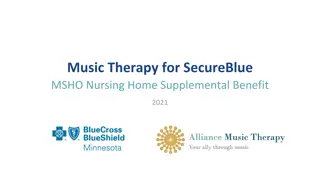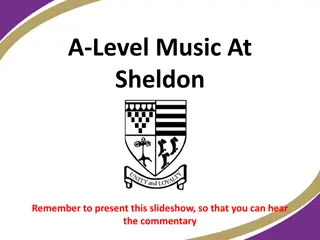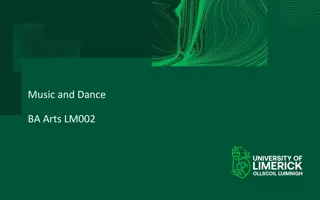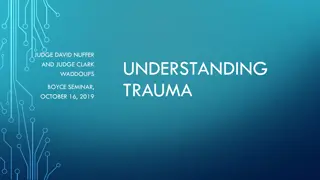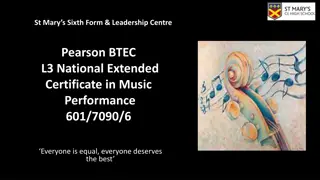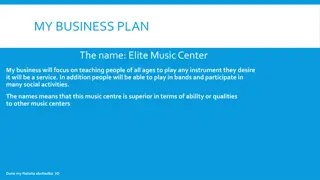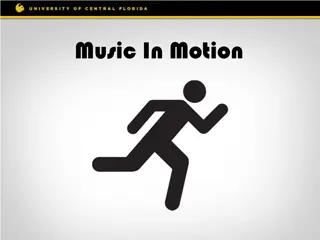The Healing Power of Music: Effects on Mind and Body
Explore the profound impact of music on human emotions and physiology. From calming patients undergoing surgery to influencing consumer behavior, music has diverse effects. Entrainment of physiological rhythms, animal reactions, and addiction to music are discussed, highlighting the therapeutic potential in pain control and mental well-being.
Download Presentation

Please find below an Image/Link to download the presentation.
The content on the website is provided AS IS for your information and personal use only. It may not be sold, licensed, or shared on other websites without obtaining consent from the author. Download presentation by click this link. If you encounter any issues during the download, it is possible that the publisher has removed the file from their server.
E N D
Presentation Transcript
SOOTHING THE SAVAGE BREAST Glenn Wilson PhD, Gresham College, London
Musick has charms to soothe the savage breast, To soften rocks, or bend a knotted oak. William Congreve (English dramatist, 1670 - 1729) The Mourning Bride, Act 1 Scene 1.
MUSIC OF THE SPHERES Music has been extolled for its healing powers since antiquity. Ancient Egyptians, Sumerians, Greeks, Hindus and Chinese saw magical, spiritual and cosmological significance in sound patterns. Orpheus charms the beasts with his lyre (Roman mosaic).
SOME EFFECTS OF MUSIC 1. Calming people undergoing surgery 2. Managing pain in hospices/dentistry 3. Bolstering the immune system 4. Reviving memories in elderly 5. Improving fluency in speech disorders 6. Motivating/pacing Parkinson s patients 7. Reducing epileptic seizures 8. Enhancing stroke recovery 9. Social bonding 10. Influencing consumer behaviour 11. Controlling vandalism
ENTRAINMENT Music gains much of its effect by pacing physiological rhythms such as heart rate, respiration, brain waves and physical activity. When slow and regular it is relaxing (esp. 72bpm), when fast, loud & jerky it tends to be arousing. Major modes are positive, minor keys convey mystery/sadness. Repetitive rhythms may induce trance. Dissonance is anxiety-evoking. Music may motivate, providing prompts that combat stammering and motor disorders.
ANIMAL REACTIONS Music can calm or induce stress in animals. Dogs in a shelter are soothed by classical music more than pop or heavy metal (they rest more & bark less). Slow tempo music increases milk yield in dairy cows. Stress-inducing rock music retards wound healing in rats.
ADDICTED TO MUSIC? When people experience chills from listening to their favourite music dopamine is released in the mesolimbic regions of their brain the reward areas that mediate pleasure & addiction (Salimpoor et al, 2011). This might help Parkinson s sufferers who produce insufficient dopamine for movement and depressed patients whose responses are diminished (Osuch et al, 2009).
PAIN CONTROL Music may be effective in reducing pain after surgery or in palliative care. However, this applies more to self-reported pain than reductions in self- administered analgesia. Positive benefits (when observed) may be due to distraction, relaxation, sense of control, or release of dopamine/endorphins.
ENHANCED IMMUNITY Mood-enhancing music has been found to reduce stress hormones (cortisol), increase DHEA, and potentiate secretory immunoglobulin. This is seen in healthy individuals as well as those with clinical conditions like anxiety, depression, chronic fatigue and arrhythmias (McCraty, 1999).
CARDIOVASCULAR EFFECTS Cardiovascular variables are entrained with classical music (Bernardi et al, 2009). Crescendos cause vasoconstriction and raise blood pressure; slower more regular music lowers BP. These effects apply regardless of musical training. Relaxing music lowers anxiety in pre-operative settings, reducing need for premedication. Recovery from heart surgery is improved by classical & meditational music whereas heavy metal & techno may be detrimental (Trappe 2010).
PREFERRED MUSIC Some medical benefits depend on music being enjoyed by the individual. Cardiovascular risk, as indicated by blood circulation measures, is lowered by music chosen by individual as joyful but adversely affected by music nominated as anxiety inducing (Miller et al, 2008). Soto et al (2009) reported improvement in neurological patients with visual neglect when tasks were performed with preferred (pleasant) music but not with non-preferred music or silence.
WHY DO WE LIKE SAD MUSIC? Sad music provides empathetic support (validation) for our own sadness, the reassurance that others feel it too. Sorrowful music (such as Barber s Adagio for Strings) may release the consoling effects of prolactin - a hormone associated with pregnancy, lactation & weepy feelings (Huron, 2011). Prolactin counters grief and it may be pleasurable in situations where the grief is not real. Nostalgia in music may be associated with secretion of bonding hormone oxytocin.
REMINISCENCE THERAPY Music is an important component of reminiscence therapy for older people with dementia. The idea is to restimulate happy memories from the past and induce a sense of familiarity and security. Music has a better chance of connecting with patients in long-term coma than speech (Aldridge et al, 1990). There are instances of people being revived from coma by music of personal significance.
BRAIN HUB FOR MUSICAL NOSTALGIA Janata (2009) has found an area in the dorsomedial prefrontal cortex that links familiar music with salient, emotionally- charged memories from our past. Since this is one of the last areas to atrophy in Alzheimer s, it may explain why music continues to elicit strong emotions in these patients. fMRI responses to music that is familiar (green), enjoyable (blue), memory evoking (red), familiar + evocative (yellow).
MOZART HELPS WITH EPILEPSY The original Mozart Effect was a supposed improvement on spatial reasoning tasks. This has not been consistently replicated, but a reduction in epileptic seizures has been confirmed in children during and after listening to K.448 (Sonata for Two Pianos in D major). The benefit seems to last for at least 6 months (Lin et al, 2011). Effect also found with a piece by Greek-American singer Yanni (Acroyali/Standing in motion), which has similar tempo, structure, consonance and predictability to K448.
TEMPO AND MODE Mozart effects, when observed, may be mediated by arousal and mood. Cognitive performance is better following a fast/major performance of K.448 than a slow/minor one. Subjects in the fast conditions reported higher arousal and those in the major reported more positive mood. (Husain et al, 2002)
LEARNING DISABLED The Nordoff- Robbins approach involves working one-on-one, especially with learning disabled and emotionally disturbed children. The idea is that it opens a channel of expression that does not require high level language skills. Programme is tailored to individual but often involves improvised musical dialogue between therapist and client.
GOOD VIBRATIONS Vibroacoustic therapy refers to idea that vibration delivered tactilely is therapeutic aside from music. Recommended esp. for cerebral palsy & arthritis. Various devices offered, including mats, chairs & baths. May combine vibration with musical sound - sometimes also light shows. Usually enjoyable but scientific evaluation is sparse.
EVALUATING MUSIC THERAPY Gold standards for evaluating treatments are the random controlled trial (RCT) and meta- analysis. Difficult to apply in music therapy because clients, procedures and outcomes are highly variable and complex. Meta-analysis shows that effect sizes for music in medical treatment are greater for women (.90) than men (.57), and greater for children & adolescents (.95) than adults (.87); infants show least response (.48).
DEPRESSION IN OLDER PEOPLE Hanser & Thompson (1994) compared: (1) music-listening guided by weekly visits from a therapist. (2) self-administered music with telephone back-up. (3) wait-list control. Both music groups improved in self- esteem and mood compared with controls. Concluded that home-bound elders benefit from music interventions. But hard to know it was the music that was therapeutic rather than just the feeling of being helped.
STROKE RECOVERY A better controlled study is that of Sarkomo et al (2008). Daily listening to self-selected music in the early post-stroke stage enhanced cognitive recovery relative to audio books and no-music controls (Sarkamo et al 2008). Verbal memory improved more in the music group than either audio books or non-listening. Focused attention improved significantly in the music group but not the other two groups.
BENEFITS OF SINGING Singing has benefits to the performer as well as audience: 1. Respiratory & cardiovascular (aerobic) effects. 2. Neurological functioning (e.g. alertness, learning). 3. Enhanced immune functioning (measured by salivary immunoglobulin). 5. Catharsis experience & expression of emotion. 6. Mood enhancement positive feelings & improved self-concept. 7. Social benefits rapport with others (esp. in choral performance).
MUSIC AND SOCIAL BONDING Joint musical performance creates powerful social bonds the feeling of being in harmony with others. Shared musical taste also increases social attraction because it is a cue to shared values (Boer et al, 2011). These social benefits may counteract loneliness and depression.
NEGATIVE EFFECTS? Is rock music is responsible for breakdown of sexual restraint and increased aggressiveness in society? Research suggests that pop reflects societal attitudes rather than driving them. Pop music expresses teenage rebellion (chosen to annoy parental generation). Jerry Lee Lewis, Mick Jagger, the Sex Pistols, Marilyn Manson all created outrage at the time but seem pantomime in retrospect.
DREAM DECEIVERS In 1985, rock group Judas Priest went on trial in Reno accused of causing a suicide pact between two unstable young men by subliminal messages in their music. Although they were acquitted, there is evidence of a link between interest in rock/rap and self-harm, perhaps mediated by background and self-esteem.
COUNTRY MUSIC & SUICIDE Sociologists Stack & Gundlach (1992) reported a link between airtime devoted to country music and suicide rates across 49 U.S. cities. This was unconnected with divorce, poverty, southernness and gun availability. Suggested that recurrent themes (marital discord, social alienation, alcohol abuse) promote suicide by nurturing pre-existing suicidal mood.
SUMMARY: MEDICAL USES OF MUSIC 1. Boosting mood (and immunity). 2. Energisation (depression, psychomotor conditions). 3. Relaxation & stress management (anxiety, cardiovascular patients) 4. Reviving happy memories, thus improving quality of life (Alzheimer s disease). 5. Distraction from unpleasant realities (cancer patients, analgesia). 6. Providing a non-verbal channel of communication & expression (e.g., learning disabled, stroke patients). 7. Social rapport (group singing) Doctors in Turkey use traditional Islamic music in hospital.



